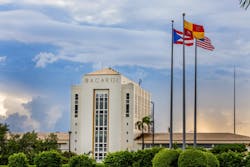Bacardi rum distillery CHP plant cutting GHG emissions by shift from fuel oil to propane
A new combined heat and power plant at Bacardi's rum distillery in Puerto Rico will cut on-site carbon emissions by half when it is commissioned next year, the company said.
The new CHP plant will be fueled by propane gas, which is more efficient and emits less greenhouse gases than the current heavy fuel oil being used at the distillery power generation operations. Puerto Rico is limited on infrastructure for power generation fuel resources.
“As a brand and as a company, we are committed to doing the right thing for the planet,” said Ned Duggan, Senior Vice President, Bacardi rum. “Our rums are made in Puerto Rico, a beautiful island in the Caribbean where we are continuously investing in new innovations that will ensure we do just that. This year, we are celebrating our 160th anniversary and while we reflect on our incredible history we are also looking forward to a more sustainable future.”
The 50% reduction in Bacardi rum’s GHG emissions at the Puerto Rico distillery will represent a 14% cut in the total emissions globally for family-owned Bacardi, whose portfolio of premium brands also includes well-known brands of gin, tequila and vodka. The company plans to cut GHG emissions 50 percent overall by 2025.
“We are committed to cutting our GHG emissions by reducing our energy consumption and switching to the most sustainable form of energy in the countries where we operate,” added Rodolfo Nervi, VP Global Safety, Quality & Sustainability for Bacardi. “While propane gas is the most responsible energy source in Puerto Rico right now, we are continuing to explore ways in which we can reduce our use of carbon-based fuels even further and take more positive steps towards our ultimate goal of Net Zero.”
